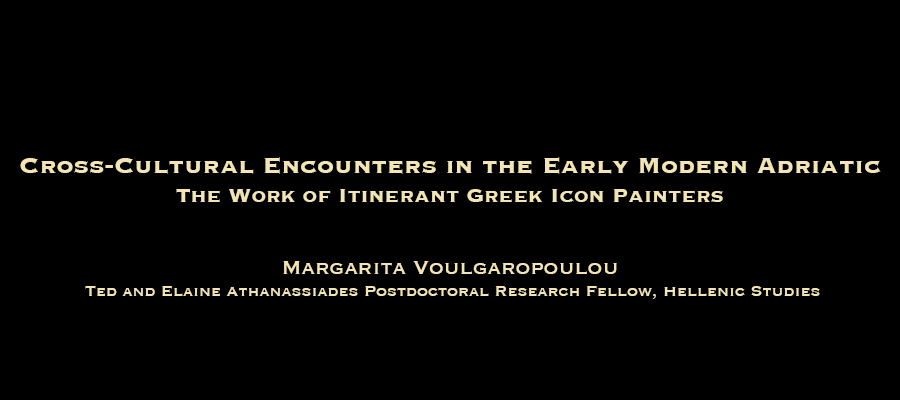Cross-Cultural Encounters in the Early Modern Adriatic: The Work of Itinerant Greek Icon Painters, lecture by Margarita Voulgaropoulou (Princeton University), Seeger Center for Hellenic Studies, Princeton University, October 13, 2015, 4:30 pm
Respondent: Charles Barber, Department of Art and Archaeology, Princeton University
Spanning the entire early modern period and covering a vast geographic area that includes modern--‐day Italy, Croatia, Slovenia and Montenegro, the activity of itinerant Greek icon painters in the Adriatic is manifested not only in the archival sources, but mostly in the numerous icons displayed in churches, museums and private collections. Renowned for their ability to paint in both the Byzantine and Western traditions, Greek icon painters appealed to an extensive patronage network that transcended ethnic, socio-economic, religious, and geographical boundaries. The high demand for icons from such a vast demographic resulted into a notable rise in the import of icons in the Adriatic markets, culminating in the establishment of flourishing icon painting workshops in several port cities of the Italian and Dalmatian coast. This lecture will delineate the wide range of artistic, political, religious, and socio-economic factors that contributed to the dissemination of icon painting in both Adriatic shores and instigated the establishment of Greek artists in the Adriatic. In particular, by tracing the cultural remnants of Byzantine tradition in the Adriatic, and taking into account the artistic and religious reforms introduced by the Post-Tridentine Catholic Church, the paper will discuss the unexpected diffusion of icon painting in the Renaissance and Baroque eras. The presence of Greek icon painters in the Adriatic will be associated with the geopolitical turmoil in the Eastern Mediterranean, the migratory flows, and the foundation of new Orthodox communities, thus illuminating the symbiotic cultural environment of the Early Modern Adriatic, and gauging the dynamics of coexistence between Greek, Italian, Slavic, and, Albanian populations.
Margarita Voulgaropoulou earned her doctoral degree in 2014 from the Department of Art History at the Aristotle University of Thessaloniki. In her doctoral dissertation, she investigated the reception of icon painting in the broad Adriatic area from the fifteenth to the seventeenth century, emphasizing on the cross-cultural exchanges between the Eastern Mediterranean, the Italian Peninsula, and the Western Balkans. She has presented papers at international conferences, and has published articles on Byzantine, Post-Byzantine and European art. She is currently revising her doctoral dissertation for publication, while embarking on a new research project on the work of Heptanesian artists in the Adriatic in the eighteenth and nineteenth centuries. Her academic research interests include Italian Renaissance Art, Byzantine and Post-Byzantine Culture, history of the Adriatic, and the Eastern Mediterranean.
